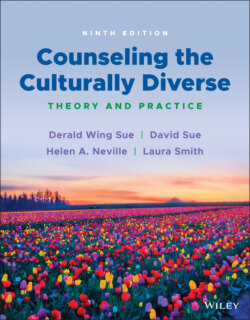Читать книгу Counseling the Culturally Diverse - Laura Smith L. - Страница 32
BEHAVIORAL RESISTANCE
ОглавлениеWhite racial guilt involves realizing one's potential culpability over past deeds; guilt is compounded by the knowledge that continued inaction on one's part allows for the perpetuation of racism in oneself and others. Thus, taking action is a means to alleviate feelings of guilt. The emotions of helplessness and hopelessness make themselves felt in two different arenas: one is internal (personal change) and the other is external (system change). In becoming aware of their racial/cultural identity, for example, White students at this juncture of development may begin to ask two primary questions.
First, “How does one change?” What needs to be changed? How does one become a nonracist or an unbiased person? How does one break the shackles of social conditioning that have taught one that some groups are more worthy than others, and that other groups are less worthy? Many trainees often make these comments: “I don't know where to begin.” “If I am not aware of my racism, how do I become aware of it?” “Tell me what I must do to rid myself of these prejudices.” “Should I attend more workshops?” “I feel so confused, helpless, impotent, and paralyzed.”
Second, “What must I do to eradicate racism in the broader society?” While self‐change requires becoming a nonracist person, societal change requires becoming an antiracist one. Affecting an ethnocentric mental health delivery system falls into this category. This role means becoming an advocate and actively intervening when injustice makes its presence felt at the individual level (for example, objecting to a racist joke or confronting friends, neighbors, or colleagues about their prejudices) and at the institutional level (for example, opposing biased mental health practices, supporting civil rights issues, making sure a multicultural curriculum is being taught in schools, or openly supporting social justice groups).
The helplessness that is felt by White students in diversity studies, unless adequately deconstructed, can easily provide an excuse or rationalization for inaction. “What good would it do?” “I'm only one person, how can I make any difference?” “The problem is so big, whatever I do will only be a drop in the bucket.” Feeling helpless and hopeless is legitimate unless it is used as an excuse to escape responsibility for taking any form of action. Helplessness is modifiable when students are provided options and strategies that can be used to increase their awareness and personal growth, and when they are provided with the tools to dismantle racism in our society. Hopefully, this course and the readings will provide you with suggestions of where to begin, especially in mental health practice.
Hopelessness is a feeling of despair and of giving up, a self‐belief that no action will matter and no solution will work. Helplessness and hopelessness associated with the need for change and action can be paralytic. The excuse for inaction, and thus the avoidance of racial exploration, resides not simply in not knowing what to do, but in some very basic fears eloquently expressed by Tatum (2002).
Fear is a powerful emotion, one that immobilizes, traps words in our throats, and stills our tongues. Like a deer on the highway, frozen in the panic induced by the lights of an oncoming car, when we are afraid it seems that we cannot think, we cannot speak, we cannot move … What do we fear? Isolation from friends and family, ostracism for speaking of things that generate discomfort, rejection by those who may be offended by what we have to say, the loss of privilege or status for speaking in support of those who have been marginalized by society, physical harm caused by the irrational wrath of those who disagree with your stance? (pp. 115–116)
In other words, helplessness and hopelessness are emotions that can provide cover for not taking action. They allow many of us to not change for fear that our actions will result in the negative consequences previously outlined. Becoming a multiculturally competent counselor or therapist requires change.
